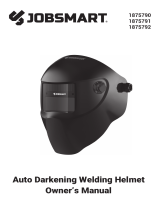
INSTRUCTIONS FOR
WELDING HELMET AUTO DARKENING SHADE 9-13
MODEL NO: PWH600.V2
Thank you for purchasing a Sealey product. Manufactured to a high standard, this product will, if used according to these
instructions, and properly maintained, give you years of trouble free performance.
PLEASE READ THESE INSTRUCTIONS CAREFULLY. NOTE THE SAFE OPERATIONAL REQUIREMENTS, WARNINGS & CAUTIONS. USE
THE PRODUCT CORRECTLY AND WITH CARE FOR THE PURPOSE FOR WHICH IT IS INTENDED. FAILURE TO DO SO MAY CAUSE DAMAGE AND/OR
PERSONAL INJURY AND WILL INVALIDATE THE WARRANTY. KEEP THESE INSTRUCTIONS SAFE FOR FUTURE USE.
1. SAFETY
R WARNING! This helmet is not suitable for use with laser welding or CUTTING or for overhead welding applications.
Ensure all workshop safety rules, regulations and conditions are complied with when using welding equipment. The helmet will not offer
protection against misuse of workshop tools, equipment, or accessories.
Maintain the helmet in good condition and protect cartridge from liquid and dirt contact. Regularly replace the protective lens and
replace any damaged or worn parts. Use genuine parts only. Unauthorised parts may be dangerous and will invalidate the warranty.
Ensure the front cover window is securely in place before use.
Fit the helmet and adjust the head band so the helmet will sit as low and near to your face as possible.
Use helmet only in temperatures ranging from -10°C to 60°C.
Remove ill tting clothing, remove ties, watches, rings and other loose jewellery.
Maintain correct balance and footing.
Ensure the oor is clear from obstructions, not slippery and wear non-slip shoes.
Keep children and unauthorised persons away from the working area.
R WARNING! The helmet will only protect the eyes and face from radiation and sparks. It will not protect against explosive devices or
corrosive liquids.
DO NOT use helmet for any purpose for which it is not designed.
DO NOT use helmet unless you have been instructed in its use by a qualied person.
DO NOT open or tamper with the shade cartridge.
DO NOT get the helmet wet or use in damp or wet locations.
DO NOT leave work place with helmet in lowered position, as bright light source may darken cartridge unexpectedly.
DO NOT place the helmet on a hot surface.
DO NOT use helmet without front cover window tted. To do so will invalidate your warranty.
Clean helmet (see section 5.4) and store the helmet in a safe, dry, childproof location.
RWARNING! Before welding always inspect the cartridge lter to ensure that it is not damaged. To test the lter prior to welding, direct
the front of the cartridge lter to a bright light source which will cause the lens to darken. Then using your hand rapidly cover and
uncover the sensor. The lter should lighten momentarily then return to a dark state.
R WARNING! DO NOT use the helmet if damaged or you suspect it may be faulty. (Contact Sealey stockist).
VDANGER! DO NOT USE if, at any time, the face plate in the cartridge FAILS to darken when exposed to a welding spark. Remove
cartridge and return to your Sealey stockistfor checking.
VContinued use of the product knowing that the auto darkening feature is NOT FUNCTIONING may DAMAGE YOUR EYES and
CAUSE BLINDNESS.
2. INTRODUCTION
High quality innitely variable shade 9-13 lens manufactured and tested to BS EN 379. Fully automatic switching from light to dark on striking
arc. Fitted with solar power panel - no batteries required. Features innitely adjustable sensitivity and delay switches. Grinding function
enables user to grind without removing mask. Deluxe contoured helmet approved to BS EN 175 which gives full neck protection and protects
lens from scratching when helmet is laid down. Comfortable headband and non-slip quick release ratchet mechanism. Suitable for MIG, TIG
and arc welding.
3. SPECIFICATION
Model No: ...........................................................PWH600.V2
Shade active: .................................................... 9-13 variable
Shade inactive: ....................................................................4
Grinding function: ............................................................. yes
Viewing area: ..................................................... 100 x 45mm
Operating time light/dark: ............................................. 0.3ms
Operating temperature: ..................................-10°C to +60°C
Power: ....................................................................solar cells
Weight: ...........................................................................570g
PWH600.V2 | Issue 2 (H,F) 21/12/17
Original Language Version
© Jack Sealey Limited
Refer to
instruction
manual









